Corsair has been in the SSD game going all the way back to when it started and while the focus recently has been on PCIe Gen 4.0 drives for most companies. Corsair was early to that back when PCIe 4.0 was first available over a year ago at the X570 launch. With that in mind, they are still launching PCIe 3.0 drives as well to give new options for those who don’t have 4.0 or don’t want/need the extra speed or costs. So they introduced the MP400 this past October. It is available in 1TB, 2TB, 4TB, and 8TB options and features 3D QLC NAND. Today I’m going to check out the 1TB model which is Corsair's cheapest 1TB SSD option to test its performance and see how it fits in today's market.
Product Name: Corsair MP400 1TB
Review Sample Provided by: Corsair
Written by: Wes Compton
Amazon Affiliate Link: HERE
|
Specifications |
|
|
Capacities Available |
1TB, 2TB, 4TB, 8TB |
|
SSD Interface |
PCIe Gen 3.0 x4 |
|
NAND Technology |
3D QLC NAND |
|
Form Factor |
M.2 2280 |
|
Dimensions |
80mm x 23mm x 15mm |
|
SSD Smart Support |
Yes |
|
Encryption |
AES 256-bit Encryption |
|
SSD Max Sequential Read CDM |
Up to 3,480MB/s |
|
SSD Max Sequential Write CDM |
Up to 1880MB/s |
|
Max Random Write QD32 IOMeter |
Up to 470K IOPS |
|
Max Random Read QD32 IOMeter |
Up to 190K IOPS |
|
Power Consumption active |
4.0W Average |
|
Voltage |
3.3V, +/- 5% |
|
DEVSLP |
PS4: <2mW |
|
Storage Temperature |
-40°C to +85°C |
|
SSD Operating Temperature |
0°C to +70°C |
|
SSD Shock |
1500 G |
|
Storage Humidity |
93% RH (40° C) |
|
Operating Humidity |
90% RH (40° C) |
|
Vibration |
20Hz~80Hz/1.52mm 80Hz~2000Hz/20G |
|
Weight |
0.034kg |
|
Endurance |
200TBW |
|
TBW |
200 |
|
MTBF |
1,800,000 Hours |
|
Warranty |
5-Year |
|
Package Contents |
MP400 M.2 SSD Quick Start Guide |
Photos and Features
The MP400 comes in a small box which unsurprisingly is bright yellow. This is Corsair's signature color and most of their products have it. The front has the model name visible with a large bold font and they also have a picture of the drive itself which I like. Below the model name Corsair does list that this is an NVMe drive and that it is PCIe Gen 3. Below that they have the capacity as well as a little information on the drive's speed which has this up to 3480 MB/s on the read side of things and 1880 MB/s on the writes. Around on the back, the box has a small window that lets you look inside and confirm that the drive inside is the drive you expect it to be and to see the serial number. The back doesn’t have much going on other than a short description which is repeated in multiple languages.


Inside the box, the MP400 comes in a clear plastic clamshell tray that keeps it from being damaged. Then for documentation, they have a small paper with the safety information and another which has an installation guide.


The drive itself is a relatively standard M.2 drive including its M.2 2280 length. Corsair went with a black PCB which matches the black sticker on top which has the MP400 model name in its large font. Below that they still mention it is an NVMe drive as well as it being a PCIe Gen 3 drive running at x4 lanes. It also has the Corsair sail logo over on the left.


The back side of the drive has the information sticker. That sticker includes the serial number and bar code as well as all of the required regulator certification logos. The drive capacity is here as well but is in the smallest possible font, I think making that a little larger and easier to spot could be helpful, or putting it on the front sticker as well. The back of the drive itself is bare but you can see mounting pads on the PCB for four NAND and DRAM which I would assume are put to use on the larger capacity drives. Our 1TB model is the smallest option from Corsair for the MP400.

On the top side, with the sticker pulled off, we can see that even with this being the smallest capacity drive Corsair has still filled this side up. There are four NAD chips on the left. They are etched with IA5BG67AWA which is a Micron 96-layer 3D QLC NAND and given the capacity we can assume these are 256GB chips. Next to those, the silver chip is the controller. This is a Phison E12S with the full model number on the chip being PS5012-E12S-32. The E12S is an eight-channel controller but with this 1TB model, it is only using half of that for a four-channel controller. Then on the end, next to the controller is one DDR chip. This is a Nanya chip labeled NT5CC256M16ER-EK which is a 4GB density 1866Mbps DDR3 die for the cache. When going through these details on the MP400 I did realize that it was very familiar, the Sabrent Rocker Q that I took a look at last June has the same setup except for the brand of the cache. Other than PCB color they have the same look and layout as well.


Test System (with affiliate links)
Motherboard: Asus ROG X570 Crosshair Hero w/WiFi
CPU: AMD Ryzen 9 3900X
Motherboard: Asus Crosshair VIII HERO WiFi
Cooling: Corsair H100i RGB Platinum for cooling
Noctua NT-H1 Thermal Paste
Memory: G.Skill Trident Z Royal 3600MHz 16-16-16-36
Storage: Corsair MP600 2TB
Video Card: Nvidia GTX 1080 Ti
Power Supply: Corsair TX750M
Case: Dimastech Test Bench
|
Test Procedures |
|
|
CrystalDiskMark |
Sequential read and write speed testing and random read/write IOPS with 8qd and 8thread test. Testing is done on CDM 7 as noted |
|
AS SSD |
File Copy benchmark using ISO, Program, and Game settings |
|
Passmark Performance Test 9 |
Advanced Disk Benchmark using the four default tests Database, File Server, Web Server, and Workstation. We also test overall Storage Score. Normal Passmark storage test is also run with the overall score documented. |
|
Anvil's Storage Utilities |
We run the whole SSD benchmark but only use the 4K QD16 IOPS for random read performance |
|
Queue Depth Testing |
This uses Anvil’s as well, but we run individual tests set to 4k file size at a queue depth from 1, 2, 4, 8, 16, 32, 64, and for read speeds 128 |
|
Real-World Test |
File transfer tests are done in Windows 10 using the default transfer tool. Tests are done with a folder filled with Word Documents, a folder filled with JPG and RAW photos, and a folder filled with movies |
Performance
Before jumping into my testing I did run CystalDiskInfo, this was just to confirm that the MP400 was running at the correct speed. It is a PCIe 3.0 drive which is supported by new and old configurations so that wasn’t an issue. I was also running with x4 PCI lanes which is what it needs so we were good to go. The CrystalDiskInfo also documents the firmware and you can see it was running on the standard NVM 1.3 driver.

My first round of testing was using CrystalDiskMark 7. I’ve got the CDM7 results next to other NVMe drives. The Rocket Q which has the same controller and NAND but in the 2TB capacity was of interest as well. The MP400 1TB did well on the sequential read speed which being a PCIe 3 drive was maxed out at 3095 MB/s but you can see how much things drop off on the reads when you get down to the random 4k at a queue depth of 32 with 16 threads, being the second slowest drive tested there. The 2TB rocket Q was much faster there. The write performance of the MP400 drops off significantly for the sequential results. In fact, the 2070 MB/s is a little faster than Corsair's specifications suggest. This is exclusive to the 1TB model MP400, the higher capacities all take full advantage of the eight-channel controller and are faster on the writes which you can see where the Rocket Q 2TB maxes out PCIe 3. The Q32T16 results on the writs are better than the reads were at least which should mean decent write IOPS. The IOPs results so show that the MP400 1TB isn’t great in overall IOPs performance, but the writes are noticeably higher than on the reads.



I tested using PCMark 10 which uses real work like situations in the full system benchmark to put together an overall score. The MP400 1TB did well on the Data Drive Benchmark, coming in behind the Rocket Q and the VPR100, but it was really bad on the full system benchmark in PCMark 10.

With AS SSD, I skipped doing the normal tests which are similar to CyrstalDiskMark, and went with their timed file transfer tests. This transfers three types of files with the lowest being the best. I stacked all three results together because I want to see which drives are the fastest overall. The MP400 didn’t do too bad with the program files with only the Rocket Q being faster, but the ISO and Game files put it behind, making its overall performance average.

In Passmark Performance Test 9 I ran two sets of tests. I did the combined Passmark Storage Score which runs a few tests and averages out a score. Then I ran the advanced disk benchmarks which let us run a few default tests focused on potential enterprise performance. In the advanced disk benchmark the database result was the only area that the MP400 1TB stood out, the other three it came in behind other drives. Especially when compared to the Rocket Q 2TB. The Passmark Disk mark score showed the MP400 1TB ahead of a lot of the cheaper SSDs but all of the flagship drives, as well as the WD Blue SN550, were out ahead of it by a significant margin.


In Anvil’s Storage Utilities I ran the full test but focused on the IOPS performance at a queue depth of 16 for both read and write performance. The Corsair MP400 1TB didn’t do that bad here actually. This was mostly because of the write IOPS which were one of the fastest for PCIe Gen 3 drives. The read IOPS on the other hand weren’t as good. But combined it put the 1TB MP400 up ahead of the average.

The second half of my Anvil’s Storage Utilities benchmarking was using the manual benchmarks to test out the 4K read and write performance across a variety of queue depths. I started at 1 queue depth and doubled up to 128 for reads and 64 for writes. This gives us a great hook at how the drive handles different situations, some controllers get overloaded and slow down in higher queue depth situations and some drives perform better than others when at low queue depths. The 1TB MP400 did well early but well off quickly on the read performance. You can see it fall behind at a queue depth of 16 then really behind on all of the tests after that. On the write tests, again the MP400 did well early but it didn’t drop off nearly as much on the higher end this time around. Up at a queue depth of 64, it did drop in performance 100MB/s from the 32 queue depth performance. The Rocket Q was still much faster and most likely an example of what the MP400 would do on the 2TB and larger capacities.


My favorite tests aren’t any of the normal benchmarks. I like seeing the real-world performance using windows file transfers. For this, I have three large folders filled with files. One has movie files which are all large files that are great for seeing sequential performance, the second has a mix of raw and jpg pictures which don’t have the same sequential as the movies but are what you will transfer the most. Then the last folder has word documents which are all small and slow to transfer. The 1TB MP400 came in around 3.4-3.6 MB/s both on the transfer to the drive and back to the PC. The picture folder was significantly faster with it transferring at 747MB/s to the MP400 and 772MB/s back to the PC which is great. But the movie files which are the easiest to transfer were even better, it was 1.3 GB/s to the drive and then 799MB/s back to the PC.
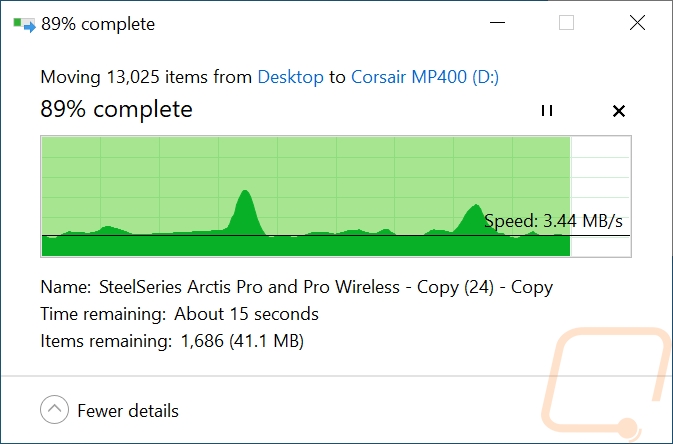
Documents to MP400
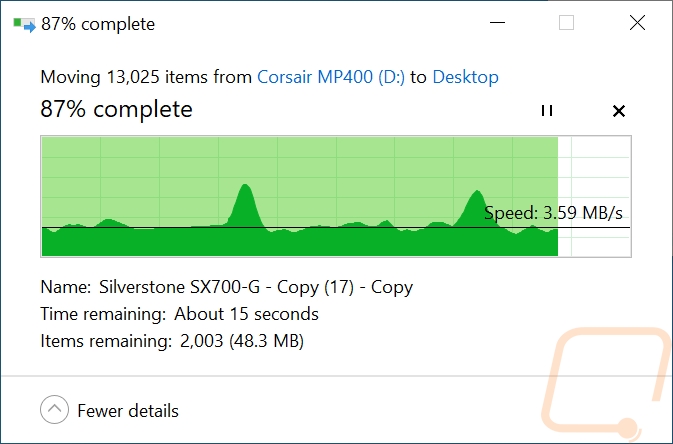
Documents to PC
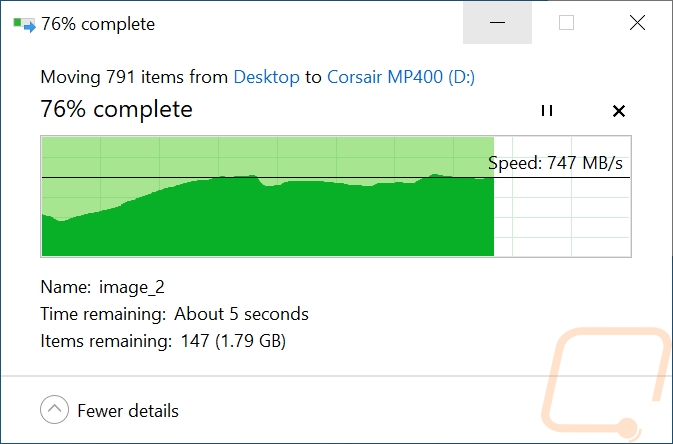
Pictures to MP400
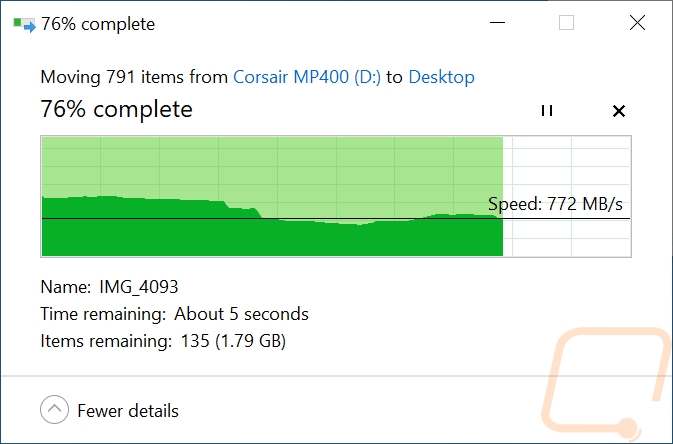
Pictures to PC

Movies to Drive
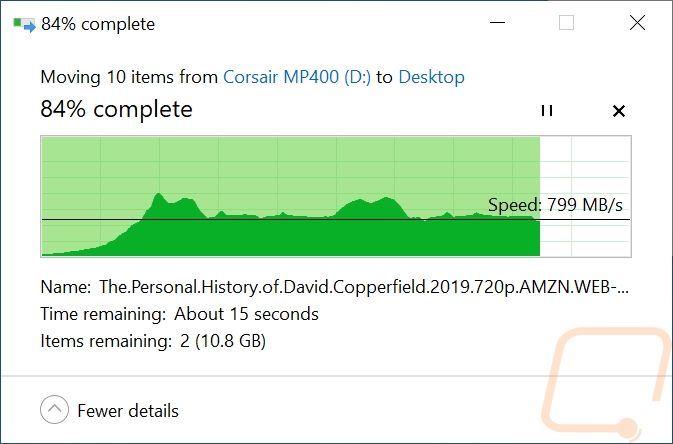
Movies to PC
My last test was to take a look at the thermals. I warmed the drive up using AID64’s drive benchmark, run for nearly a half hour then used out Flir to check out the heat. You can see that the controller is the one hot spot. With it being packed between the NAND and the cache it does heat those up slightly but not enough to show much in the thermals.

Overall and Final Verdict
Well, the MP400 is an interesting SSD to see come out this late in the game. Most companies have been focusing on their PCIe Gen 4 options but there are a lot of people who can’t even run Gen 4 SSDs yet so spending the higher prices on one wouldn’t make sense. I like the idea of bringing out lower-priced options for the mainstream. Corsair also has higher capacities in mind here. The MP400 is only available in 1TB, 2TB, 4TB, and 8TB which is getting into the range where you aren’t worried about storage anymore where some of the lower capacity M.2 drives may still mean you need a traditional SSD or hard drive if you data horde or have a lot of games that you play.
The MP400 1TB ends up being a mixed bag. I have to be clear to include the 1TB capacity when mentioning it because the 1TB model is significantly different from the other capacities Corsair has available. While it has the same controller, its performance is limited in several aspects compared to the other MP400 models. It does end up having great write IOPS performance but the write sequential performance was lower than I would like to see. The read side of things had solid sequential performance though. High queue depth situations have the MP400 struggle, especially on the read side. The one area where the MP400 1TB does still do well is with the real world windows file transfer tests, which is good to see at least.
Initially, the $119.99 MSRP wasn’t looking too bad when I was comparing it with similar 1TB options. But there is one holdup. The MP400 lineup is exactly the same as the Sabrent Rocket Q lineup and the 1TB Rocket Q is available for $10 less. Corsair is higher at the 2TB and 8TB options as well but the 4TB is a good deal at $589. Overall the 1TB option isn’t one I would recommend when drives like the SN550 are a little cheaper and faster. But getting up into the high capacity options, there aren’t as many options and the performance of the MP400 up there should be solid (see the 2TB rocket q testing I have done). It will just depend on how the pricing ends up comparing against the Rocket Q or if you are willing to pay a little extra for the Corsair name and warranty which is 5 years.

Live Pricing: HERE




